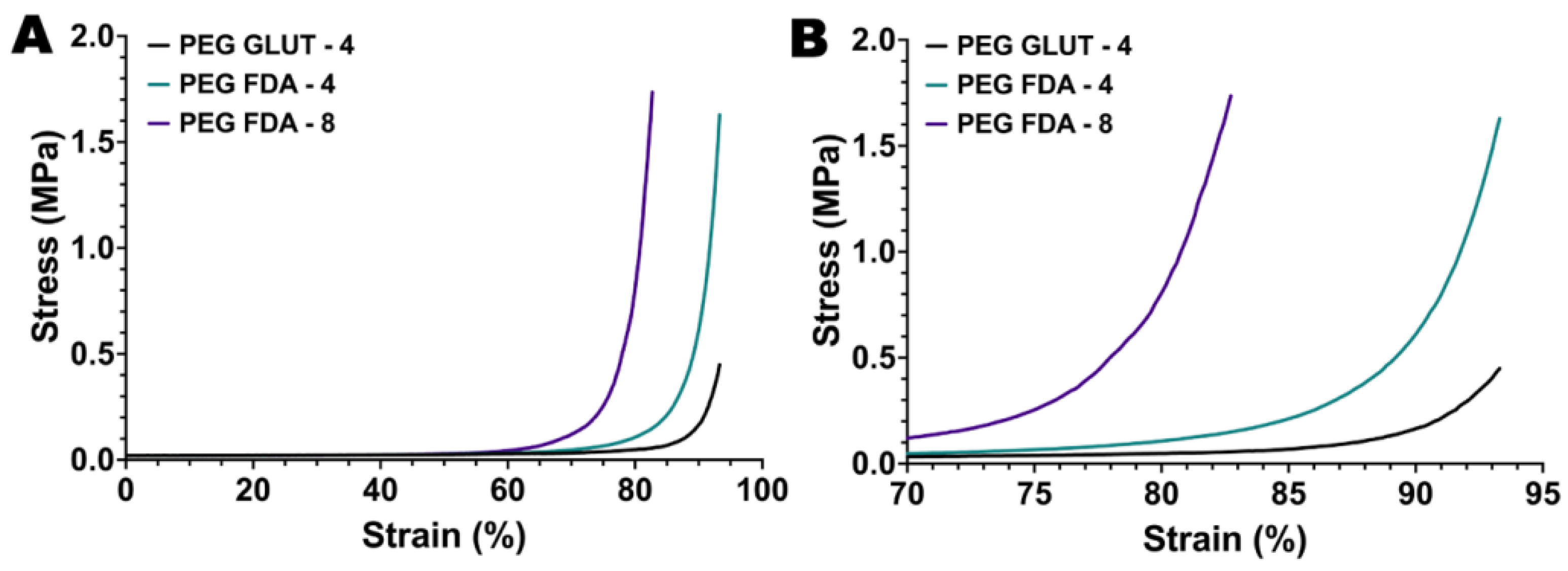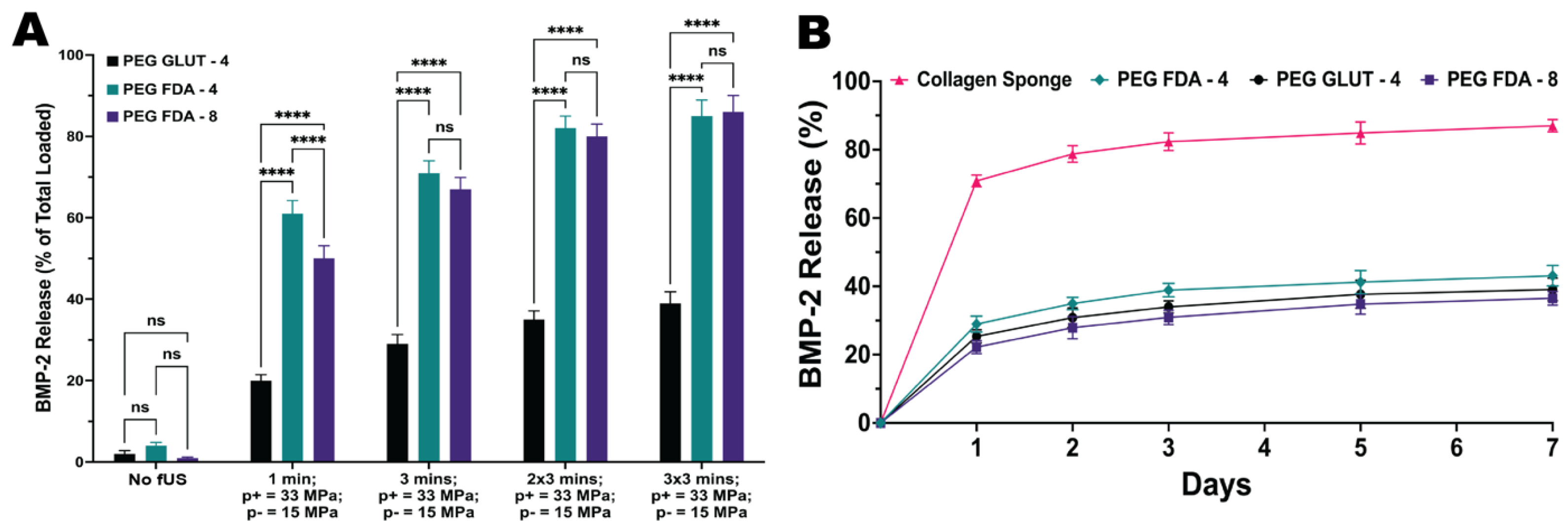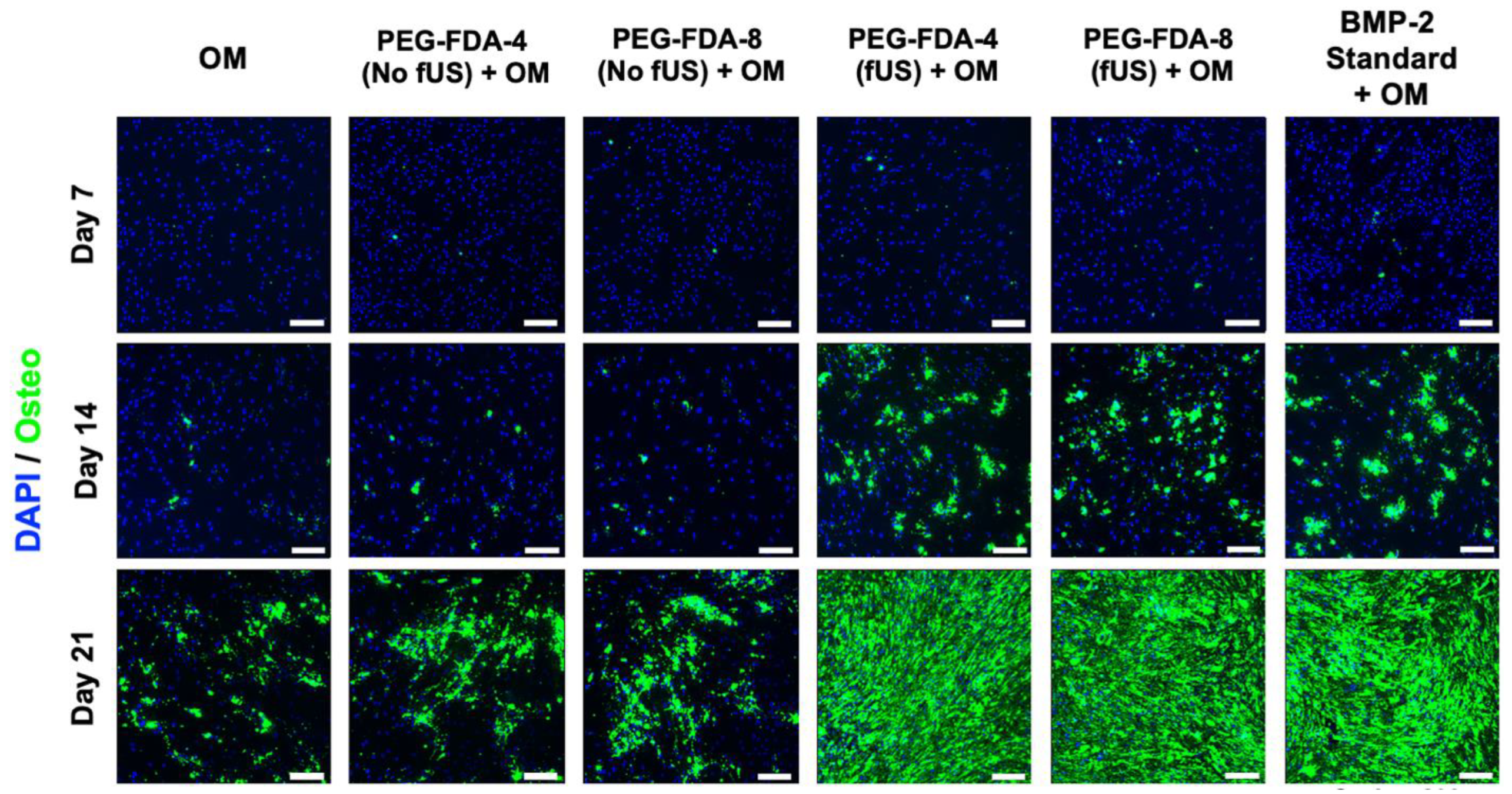Focused Ultrasound-Mediated Release of Bone Morphogenetic Protein 2 from Hydrogels for Bone Regeneration
Abstract
1. Introduction
2. Results and Discussion
2.1. Characterization and Mechanical Testing of PEG Diels–Alder Hydrogels
2.2. Immersion Heating
2.3. Ultrasound-Induced Degradation and Model Release
2.4. Cytocompatibility
2.5. Retention and fUS-Induced Release of BMP-2
2.6. Differentiation of BMSCs from fUS-Induced Release of BMP-2
3. Conclusions
4. Materials and Methods
4.1. Materials
4.2. Synthesis
4.2.1. Preparation of 4-Arm PEG-Furan
4.2.2. Preparation of PEG-FDA-4
4.2.3. Preparation of 8-Arm PEG-Furan
4.2.4. Preparation of PEG-FDA-8
4.2.5. Preparation of PEG-GLUT-4
4.2.6. Preparation of Osteogenic Medium
4.3. Experimental Approach
4.3.1. Characterization and Mechanical Testing of Hydrogel Matrices
4.3.2. Real-Time Temperature During Focused Ultrasound Exposure
4.3.3. Immersion Heating
4.3.4. Degradation Study
4.3.5. fUS-Induced Model Payload Release and Protein Activity Following fUS
4.3.6. Imaging of fUS-Induced Degradation
4.3.7. Cell Viability and Proliferation Assays
4.3.8. Hydrogel Retention and fUS-Induced BMP-2 Release
4.3.9. Alkaline Phosphatase Activity and Mineralization
4.3.10. Statistical Analysis for Studies
Author Contributions
Funding
Institutional Review Board Statement
Informed Consent Statement
Data Availability Statement
Conflicts of Interest
Appendix A











References
- Xue, N.; Ding, X.; Huang, R.; Jiang, R.; Huang, H.; Pan, X.; Min, W.; Chen, J.; Duan, J.-A.; Liu, P.; et al. Bone Tissue Engineering in the Treatment of Bone Defects. Pharmaceuticals 2022, 15, 879. [Google Scholar] [CrossRef] [PubMed]
- Alonzo, M.; Alvarez Primo, F.; Anil Kumar, S.; Mudloff, J.A.; Dominguez, E.; Fregoso, G.; Ortiz, N.; Weiss, W.M.; Joddar, B. Bone Tissue Engineering Techniques, Advances, and Scaffolds for Treatment of Bone Defects. Curr. Opin. Biomed. Eng. 2021, 17, 100248. [Google Scholar] [CrossRef]
- Zhang, T.; Wei, Q.; Zhou, H.; Jing, Z.; Liu, X.; Zheng, Y.; Cai, H.; Wei, F.; Jiang, L.; Yu, M.; et al. Three-Dimensional-Printed Individualized Porous Implants: A New “Implant-Bone” Interface Fusion Concept for Large Bone Defect Treatment. Bioact. Mater. 2021, 6, 3659–3670. [Google Scholar] [CrossRef] [PubMed]
- Schmidt-Bleek, K.; Willie, B.M.; Schwabe, P.; Seemann, P.; Duda, G.N. BMPs in Bone Regeneration: Less Is More Effective, a Paradigm-Shift. Cytokine Growth Factor Rev. 2016, 27, 141–148. [Google Scholar] [CrossRef] [PubMed]
- Vallmajo-Martin, Q.; Millan, C.; Müller, R.; Weber, F.E.; Ehrbar, M.; Ghayor, C. Enhanced Bone Regeneration in Rat Calvarial Defects through BMP2 Release from Engineered Poly (Ethylene Glycol) Hydrogels. Sci. Rep. 2024, 14, 4916. [Google Scholar] [CrossRef]
- Murugaiyan, K.; Amirthalingam, S.; Hwang, N.S.-Y.; Jayakumar, R. Role of FGF-18 in Bone Regeneration. J. Funct. Biomater. 2023, 14, 36. [Google Scholar] [CrossRef] [PubMed]
- Nakamura, K.; Koide, M.; Kobayashi, Y.; Yamashita, T.; Matsushita, M.; Yasuda, H.; Ishihara, Y.; Yoshinari, N.; Udagawa, N. Sclerostin Deficiency Effectively Promotes Bone Morphogenetic Protein-2-Induced Ectopic Bone Formation. J. Periodontal Res. 2023, 58, 769–779. [Google Scholar] [CrossRef] [PubMed]
- Miguez, P.A.; de Paiva Gonçalves, V.; Musskopf, M.L.; Rivera-Concepcion, A.; McGaughey, S.; Yu, C.; Lee, D.J.; Tuin, S.A.; Ali, A. Mitigation of BMP-Induced Inflammation in Craniofacial Bone Regeneration and Improvement of Bone Parameters by Dietary Hesperidin. Sci. Rep. 2024, 14, 2602. [Google Scholar] [CrossRef]
- Kudaibergen, G.; Mukhlis, S.; Mukhambetova, A.; Issabekova, A.; Sekenova, A.; Sarsenova, M.; Temirzhan, A.; Baidarbekov, M.; Umbayev, B.; Ogay, V. Repair of Rat Calvarial Critical-Sized Defects Using Heparin-Conjugated Fibrin Hydrogel Containing BMP-2 and Adipose-Derived Pericytes. Bioengineering 2024, 11, 437. [Google Scholar] [CrossRef]
- Lin, C.-C.; Anseth, K.S. PEG Hydrogels for the Controlled Release of Biomolecules in Regenerative Medicine. Pharm. Res. 2009, 26, 631–643. [Google Scholar] [CrossRef]
- Sun, S.; Cui, Y.; Yuan, B.; Dou, M.; Wang, G.; Xu, H.; Wang, J.; Yin, W.; Wu, D.; Peng, C. Drug Delivery Systems Based on Polyethylene Glycol Hydrogels for Enhanced Bone Regeneration. Front. Bioeng. Biotechnol. 2023, 11, 1117647. [Google Scholar] [CrossRef] [PubMed]
- Shi, J.; Yu, L.; Ding, J. PEG-Based Thermosensitive and Biodegradable Hydrogels. Acta Biomater. 2021, 128, 42–59. [Google Scholar] [CrossRef] [PubMed]
- Agarwal, T.; Celikkin, N.; Costantini, M.; Maiti, T.K.; Makvandi, P. Recent Advances in Chemically Defined and Tunable Hydrogel Platforms for Organoid Culture. Bio-Des. Manuf. 2021, 4, 641–674. [Google Scholar] [CrossRef]
- Dabbaghi, A.; Ramazani, A.; Farshchi, N.; Rezaei, A.; Bodaghi, A.; Rezayati, S. Synthesis, Physical and Mechanical Properties of Amphiphilic Hydrogels Based on Polycaprolactone and Polyethylene Glycol for Bioapplications: A Review. J. Ind. Eng. Chem. 2021, 101, 307–323. [Google Scholar] [CrossRef]
- Collins, M.N.; Cagney, L.; Thanusha, A. Chapter 6—Hydrogel Functionalization and Crosslinking Strategies for Biomedical Applications. In Hydrogels for Tissue Engineering and Regenerative Medicine; Oliveira, J.M., Silva-Correia, J., Reis, R.L., Eds.; Academic Press: Cambridge, MA, USA, 2024; pp. 105–137. ISBN 978-0-12-823948-3. [Google Scholar]
- Andrade, F.; Roca-Melendres, M.M.; Durán-Lara, E.F.; Rafael, D.; Schwartz, S. Stimuli-Responsive Hydrogels for Cancer Treatment: The Role of pH, Light, Ionic Strength and Magnetic Field. Cancers 2021, 13, 1164. [Google Scholar] [CrossRef]
- El-Husseiny, H.M.; Mady, E.A.; Hamabe, L.; Abugomaa, A.; Shimada, K.; Yoshida, T.; Tanaka, T.; Yokoi, A.; Elbadawy, M.; Tanaka, R. Smart/Stimuli-Responsive Hydrogels: Cutting-Edge Platforms for Tissue Engineering and Other Biomedical Applications. Mater. Today Bio 2022, 13, 100186. [Google Scholar] [CrossRef]
- Arjama, M.; Mehnath, S.; Jeyaraj, M. Self-Assembled Hydrogel Nanocube for Stimuli Responsive Drug Delivery and Tumor Ablation by Phototherapy against Breast Cancer. Int. J. Biol. Macromol. 2022, 213, 435–446. [Google Scholar] [CrossRef]
- Sun, Y.; Chen, L.-G.; Fan, X.-M.; Pang, J.-L. Ultrasound Responsive Smart Implantable Hydrogels for Targeted Delivery of Drugs: Reviewing Current Practices. Int. J. Nanomed. 2022, 17, 5001–5026. [Google Scholar] [CrossRef]
- Chandan, R.; Mehta, S.; Banerjee, R. Ultrasound-Responsive Carriers for Therapeutic Applications. ACS Biomater. Sci. Eng. 2020, 6, 4731–4747. [Google Scholar] [CrossRef]
- Arrizabalaga, J.H.; Smallcomb, M.; Abu-Laban, M.; Liu, Y.; Yeingst, T.J.; Dhawan, A.; Simon, J.C.; Hayes, D.J. Ultrasound-Responsive Hydrogels for On-Demand Protein Release. ACS Appl. Bio Mater. 2022, 5, 3212–3218. [Google Scholar] [CrossRef]
- Yeingst, T.J.; Arrizabalaga, J.H.; Hayes, D.J. Ultrasound-Induced Drug Release from Stimuli-Responsive Hydrogels. Gels 2022, 8, 554. [Google Scholar] [CrossRef] [PubMed]
- Yeingst, T.J.; Helton, A.M.; Hayes, D.J. Applications of Diels–Alder Chemistry in Biomaterials and Drug Delivery. Macromol. Biosci. 2024, 24, 2400274. [Google Scholar] [CrossRef]
- Li, D.; Wang, S.; Meng, Y.; Guo, Z.; Cheng, M.; Li, J. Fabrication of Self-Healing Pectin/Chitosan Hybrid Hydrogel via Diels-Alder Reactions for Drug Delivery with High Swelling Property, pH-Responsiveness, and Cytocompatibility. Carbohydr. Polym. 2021, 268, 118244. [Google Scholar] [CrossRef]
- Shi, Y.; Xu, S.; Zhao, J.; Zhu, H.; Pan, X.; Zhao, B.; Sun, Z.; Li, N.; Hou, X. Development of Injectable in Situ Hydrogels Based on Hyaluronic Acid via Diels-Alder Reaction for Their Antitumor Activities Studies. Int. J. Biol. Macromol. 2024, 262, 129642. [Google Scholar] [CrossRef] [PubMed]
- Yeingst, T.J.; Arrizabalaga, J.H.; Rawnaque, F.S.; Stone, L.P.; Yeware, A.; Helton, A.M.; Dhawan, A.; Simon, J.C.; Hayes, D.J. Controlled Degradation of Polycaprolactone Polymers through Ultrasound Stimulation. ACS Appl. Mater. Interfaces 2023, 15, 34607–34616. [Google Scholar] [CrossRef] [PubMed]
- Sanyal, A. Diels–Alder Cycloaddition-Cycloreversion: A Powerful Combo in Materials Design. Macromol. Chem. Phys. 2010, 211, 1417–1425. [Google Scholar] [CrossRef]
- Gevrek, T.N.; Sanyal, A. Furan-Containing Polymeric Materials: Harnessing the Diels-Alder Chemistry for Biomedical Applications. Eur. Polym. J. 2021, 153, 110514. [Google Scholar] [CrossRef]
- Misiakos, G.; Parmentier, L.; Van Vlierberghe, S. Modular Design of Diels-Alder Reversible Networks for the Facile Production of Highly Tunable Materials. React. Funct. Polym. 2024, 204, 106024. [Google Scholar] [CrossRef]
- Cadamuro, F.; Russo, L.; Nicotra, F. Biomedical Hydrogels Fabricated Using Diels–Alder Crosslinking. Eur. J. Org. Chem. 2021, 2021, 374–382. [Google Scholar] [CrossRef]
- Yan, J.; Gundsambuu, B.; Krasowska, M.; Platts, K.; Facal Marina, P.; Gerber, C.; Barry, S.C.; Blencowe, A. Injectable Diels-Alder Cycloaddition Hydrogels with Tuneable Gelation, Stiffness and Degradation for the Sustained Release of T-Lymphocytes. J. Mater. Chem. B 2022, 10, 3329–3343. [Google Scholar] [CrossRef] [PubMed]
- Bas, Y.; Sanyal, R.; Sanyal, A. Hyaluronic-Acid Based Redox-Responsive Hydrogels Using the Diels-Alder Reaction for on-Demand Release of Biomacromolecules. J. Macromol. Sci. Part A 2023, 60, 246–254. [Google Scholar] [CrossRef]
- Qi, J.; Wu, H.; Liu, G. Novel Strategies for Spatiotemporal and Controlled BMP-2 Delivery in Bone Tissue Engineering. Cell Transplant. 2024, 33, 09636897241276733. [Google Scholar] [CrossRef]
- Yi, Y.; Song, J.; Zhou, P.; Shu, Y.; Liang, P.; Liang, H.; Liu, Y.; Yuan, X.; Shan, X.; Wu, X. An Ultrasound-Triggered Injectable Sodium Alginate Scaffold Loaded with Electrospun Microspheres for on-Demand Drug Delivery to Accelerate Bone Defect Regeneration. Carbohydr. Polym. 2024, 334, 122039. [Google Scholar] [CrossRef] [PubMed]
- Zheng, W.; Ma, L.; Luo, X.; Xu, R.; Cao, Z.; He, Y.; Chang, Y.; You, Y.; Chen, T.; Liu, H. Ultrasound-Triggered Functional Hydrogel Promotes Multistage Bone Regeneration. Biomaterials 2024, 311, 122650. [Google Scholar] [CrossRef]
- Wang, X.; Guo, W.; Li, L.; Yu, F.; Li, J.; Liu, L.; Fang, B.; Xia, L. Photothermally Triggered Biomimetic Drug Delivery of Teriparatide via Reduced Graphene Oxide Loaded Chitosan Hydrogel for Osteoporotic Bone Regeneration. Chem. Eng. J. 2021, 413, 127413. [Google Scholar] [CrossRef]
- Morozova, S.M. Recent Advances in Hydrogels via Diels–Alder Crosslinking: Design and Applications. Gels 2023, 9, 102. [Google Scholar] [CrossRef] [PubMed]
- Kirchhof, S.; Strasser, A.; Wittmann, H.-J.; Messmann, V.; Hammer, N.; Goepferich, A.M.; Brandl, F.P. New Insights into the Cross-Linking and Degradation Mechanism of Diels–Alder Hydrogels. J. Mater. Chem. B 2014, 3, 449–457. [Google Scholar] [CrossRef] [PubMed]
- Kirchhof, S.; Brandl, F.P.; Hammer, N.; Goepferich, A.M. Investigation of the Diels–Alder Reaction as a Cross-Linking Mechanism for Degradable Poly(Ethylene Glycol) Based Hydrogels. J. Mater. Chem. B 2013, 1, 4855–4864. [Google Scholar] [CrossRef] [PubMed]
- Yasuda, K.; Sugane, K.; Shibata, M. Self-Healing High-Performance Thermosets Utilizing the Furan/Maleimide Diels-Alder and Amine/Maleimide Michael Reactions. J. Polym. Res. 2019, 27, 18. [Google Scholar] [CrossRef]
- Kassem, A.; Abbas, L.; Coutinho, O.; Opara, S.; Najaf, H.; Kasperek, D.; Pokhrel, K.; Li, X.; Tiquia-Arashiro, S. Applications of Fourier Transform-Infrared Spectroscopy in Microbial Cell Biology and Environmental Microbiology: Advances, Challenges, and Future Perspectives. Front. Microbiol. 2023, 14, 1304081. [Google Scholar] [CrossRef]
- Fan, M.; Liu, J.; Li, X.; Zhang, J.; Cheng, J. Recyclable Diels–Alder Furan/Maleimide Polymer Networks with Shape Memory Effect. Ind. Eng. Chem. Res. 2014, 53, 16156–16163. [Google Scholar] [CrossRef]
- Karami, Z.; Zolghadr, M.; Zohuriaan-Mehr, M.J. Chapter 8—Self-Healing Diels–Alder Engineered Thermosets. In Self-Healing Polymer-Based Systems; Thomas, S., Surendran, A., Eds.; Elsevier: Amsterdam, The Netherlands, 2020; pp. 209–233. ISBN 978-0-12-818450-9. [Google Scholar]
- Martinez, A.W.; Caves, J.M.; Ravi, S.; Li, W.; Chaikof, E.L. Effects of Crosslinking on the Mechanical Properties Drug Release, and Cytocompatibility of Protein Polymers. Acta Biomater. 2014, 10, 26–33. [Google Scholar] [CrossRef] [PubMed]
- Briggs, F.; Browne, D.; Asuri, P. Role of Polymer Concentration and Crosslinking Density on Release Rates of Small Molecule Drugs. Int. J. Mol. Sci. 2022, 23, 4118. [Google Scholar] [CrossRef]
- Mo, C.; Luo, R.; Chen, Y. Advances in the Stimuli-Responsive Injectable Hydrogel for Controlled Release of Drugs. Macromol. Rapid Commun. 2022, 43, 2200007. [Google Scholar] [CrossRef] [PubMed]
- Gharehnazifam, Z.; Dolatabadi, R.; Baniassadi, M.; Shahsavari, H.; Kajbafzadeh, A.-M.; Abrinia, K.; Gharehnazifam, K.; Baghani, M. Multiphysics Modeling and Experiments on Ultrasound-Triggered Drug Delivery from Silk Fibroin Hydrogel for Wilms Tumor. Int. J. Pharm. 2022, 621, 121787. [Google Scholar] [CrossRef] [PubMed]
- Dewhirst, M.W.; Viglianti, B.L.; Lora-Michiels, M.; Hanson, M.; Hoopes, P.J. Basic Principles of Thermal Dosimetry and Thermal Thresholds for Tissue Damage from Hyperthermia. Int. J. Hyperth. 2003, 19, 267–294. [Google Scholar] [CrossRef] [PubMed]
- Liu, S.; Jiang, T.; Guo, R.; Li, C.; Lu, C.; Yang, G.; Nie, J.; Wang, F.; Yang, X.; Chen, Z. Injectable and Degradable PEG Hydrogel with Antibacterial Performance for Promoting Wound Healing. ACS Appl. Bio Mater. 2021, 4, 2769–2780. [Google Scholar] [CrossRef] [PubMed]
- Madl, C.M.; Heilshorn, S.C. Rapid Diels–Alder Cross-Linking of Cell Encapsulating Hydrogels. Chem. Mater. 2019, 31, 8035–8043. [Google Scholar] [CrossRef] [PubMed]
- Sundermann, J.; Zagst, H.; Kuntsche, J.; Wätzig, H.; Bunjes, H. Bone Morphogenetic Protein 2 (BMP-2) Aggregates Can Be Solubilized by Albumin—Investigation of BMP-2 Aggregation by Light Scattering and Electrophoresis. Pharmaceutics 2020, 12, 1143. [Google Scholar] [CrossRef] [PubMed]
- Cheison, S.C.; Leeb, E.; Letzel, T.; Kulozik, U. Influence of Buffer Type and Concentration on the Peptide Composition of Trypsin Hydrolysates of β-Lactoglobulin. Food Chem. 2011, 125, 121–127. [Google Scholar] [CrossRef]
- Arrizabalaga, J.H.; Casey, J.S.; Becca, J.C.; Liu, Y.; Jensen, L.; Hayes, D.J. Development of Magnetic Nanoparticles for the Intracellular Delivery of miR-148b in Non-Small Cell Lung Cancer. Biomed. Eng. Adv. 2022, 3, 100031. [Google Scholar] [CrossRef]
- Alden, N.A.; Arrizabalaga, J.H.; Liu, Y.; Amin, S.; Gowda, K.; Yao, S.; Archetti, M.; Glick, A.B.; Hayes, D.J. Delivery of Therapeutic miR-148b Mimic via Poly(β Amino Ester) Polyplexes for Post-Transcriptional Gene Regulation and Apoptosis of A549 Cells. Langmuir 2022, 38, 9833–9843. [Google Scholar] [CrossRef] [PubMed]
- Alden, N.A.; Yeingst, T.J.; Pfeiffer, H.M.; Celik, N.; Arrizabalaga, J.H.; Helton, A.M.; Liu, Y.; Stairs, D.B.; Glick, A.B.; Goyal, N.; et al. Near-Infrared Induced miR-34a Delivery from Nanoparticles in Esophageal Cancer Treatment. Adv. Healthc. Mater. 2024, 13, 2303593. [Google Scholar] [CrossRef] [PubMed]








Disclaimer/Publisher’s Note: The statements, opinions and data contained in all publications are solely those of the individual author(s) and contributor(s) and not of MDPI and/or the editor(s). MDPI and/or the editor(s) disclaim responsibility for any injury to people or property resulting from any ideas, methods, instructions or products referred to in the content. |
© 2025 by the authors. Licensee MDPI, Basel, Switzerland. This article is an open access article distributed under the terms and conditions of the Creative Commons Attribution (CC BY) license (https://creativecommons.org/licenses/by/4.0/).
Share and Cite
Yeingst, T.J.; Helton, A.M.; Rawnaque, F.S.; Arrizabalaga, J.H.; Ravnic, D.J.; Simon, J.C.; Hayes, D.J. Focused Ultrasound-Mediated Release of Bone Morphogenetic Protein 2 from Hydrogels for Bone Regeneration. Gels 2025, 11, 120. https://doi.org/10.3390/gels11020120
Yeingst TJ, Helton AM, Rawnaque FS, Arrizabalaga JH, Ravnic DJ, Simon JC, Hayes DJ. Focused Ultrasound-Mediated Release of Bone Morphogenetic Protein 2 from Hydrogels for Bone Regeneration. Gels. 2025; 11(2):120. https://doi.org/10.3390/gels11020120
Chicago/Turabian StyleYeingst, Tyus J., Angelica M. Helton, Ferdousi S. Rawnaque, Julien H. Arrizabalaga, Dino J. Ravnic, Julianna C. Simon, and Daniel J. Hayes. 2025. "Focused Ultrasound-Mediated Release of Bone Morphogenetic Protein 2 from Hydrogels for Bone Regeneration" Gels 11, no. 2: 120. https://doi.org/10.3390/gels11020120
APA StyleYeingst, T. J., Helton, A. M., Rawnaque, F. S., Arrizabalaga, J. H., Ravnic, D. J., Simon, J. C., & Hayes, D. J. (2025). Focused Ultrasound-Mediated Release of Bone Morphogenetic Protein 2 from Hydrogels for Bone Regeneration. Gels, 11(2), 120. https://doi.org/10.3390/gels11020120






